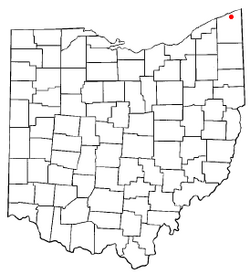Edgewood, Ohio facts for kids
Quick facts for kids
Edgewood, Ohio
|
|
|---|---|

Location of Edgewood, Ohio
|
|
| Country | United States |
| State | Ohio |
| County | Ashtabula |
| Area | |
| • Total | 6.85 sq mi (17.73 km2) |
| • Land | 6.84 sq mi (17.71 km2) |
| • Water | 0.01 sq mi (0.02 km2) |
| Elevation | 699 ft (213 m) |
| Population
(2020)
|
|
| • Total | 4,185 |
| • Density | 611.93/sq mi (236.27/km2) |
| Time zone | UTC-5 (Eastern (EST)) |
| • Summer (DST) | UTC-4 (EDT) |
| ZIP code |
44004
|
| Area code(s) | 440 |
| FIPS code | 39-24542 |
| GNIS feature ID | 2392988 |
Edgewood is a special kind of community called a census-designated place (CDP) in Ashtabula County, Ohio, United States. It's not a city or town with its own local government, but it's an area that the U.S. Census Bureau defines for gathering population information. In 2020, about 4,185 people lived there.
Where is Edgewood?
Edgewood is located in the state of Ohio. It's part of Ashtabula County. The area of Edgewood is about 17.7 square kilometers (about 6.85 square miles). Most of this area is land, with only a very small part (about 0.02 square kilometers or 0.01 square miles) being water.
Who Lives in Edgewood?
| Historical population | |||
|---|---|---|---|
| Census | Pop. | %± | |
| 2020 | 4,185 | — | |
| U.S. Decennial Census | |||
Based on information from a past census, Edgewood is home to over 4,000 people. Most residents are White. There are also smaller groups of African American, Native American, and Asian people, along with those from other backgrounds. Some people living in Edgewood are of Hispanic or Latino heritage.
Many families in Edgewood have different backgrounds. Common ancestries include German, Italian, English, Irish, American, and Finnish.
In Edgewood, you'll find people of all ages. There are children and teenagers, young adults, middle-aged people, and seniors. Many households are made up of married couples. Some households have a single parent, and others are individuals living alone.
The average income for families in Edgewood was around $46,470. A small number of people and families in the community live below the poverty line.
See also
 In Spanish: Edgewood (Ohio) para niños
In Spanish: Edgewood (Ohio) para niños

